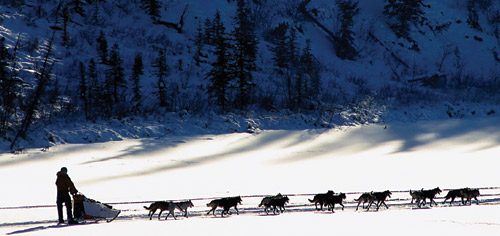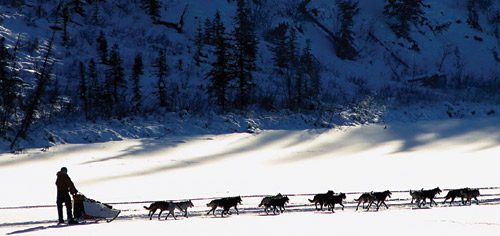

Dog-Sledding Vacations
Wild and wooly thrills
FOR THOSE OF US WHO READ JACK LONDON’S CALL OF THE WILD AS
children, the idea of racing through the snow-covered wilderness
behind a team of powerful sled dogs is likely an early
fantasy we long ago tucked away in the belief that it would
never be realized. In recent years, however, an increasing
number of winter travel destinations have begun offering dogsledding
vacation packages that can transform that old dream
into fresh reality.
Of course, a hard-core wilderness outing is not everyone’s
idea of the perfect vacation, so most sledding operations offer
trips tailored to meet a variety of tastes, from the wild to the
mild. Hearty types looking for a challenging adventure can
choose from among many competent outfitters who will teach
them to drive their own team and take them on multi-day
trips into remote wilderness areas, while those who would
prefer to briefly sample the thrill of dog sledding and then
return to a cozy luxury resort and a gourmet meal will also
find much available to them.
If you are thinking about a vacation involving dog sledding,
a good place to start is www.dogsledrides.com, an international
directory of touring kennels. This website has listings
for over 130 kennels in the U.S., as well as many in Canada
and other countries such as Finland, Great Britain, and
Germany. One of the most exotic listings is an outfitter in
Sweden who offers a package that includes dog sledding,
igloo building, and an overnight stay in the world famous Ice
Hotel—a mind-boggling structure rebuilt every year in the old
village of Jukkasjärvi in Swedish Lapland (see
www.icehotel.com). If you would prefer something a little
closer to home, just click on your state or province to find
outfitters located in your area.
What should you look for in an outfitter, and how much
should you expect to pay for your husky-powered holiday?
The answer to the latter question is that costs vary widely
depending on the length of the trip, the type of accommodation
offered, and whether or not the outfitter supplies meals,
clothing, or transportation to and from the sledding area. As
for choosing an outfitter, the musher’s experience is the key
component to ensuring that you have a safe and enjoyable
outing. “There is no officially recognized body for dog-sled
guide certification,” explains Jeninne Cathers of Cathers
Wilderness Adventures, based in Whitehorse, Yukon, “but
you want to feel that the guide has the experience to know
and care for their dogs well, and to be capable of dealing
with situations that may arise on the trail such as bad weather,
a broken sled, or even injuries should they occur. In the
Yukon, all guides must have first aid and CPR training, and
each business must have a valid wilderness tourism license.”
Cathers stresses that you should feel free to ask any questions
you might have, and suggests contacting a tourism industry
association or chamber of commerce in the area you plan to
visit if you want to further check out an operator.
Billy Snodgrass, of Continental Divide Dog Sled Adventures
in Jackson Hole, Wyoming, embodies all the qualities you
would want to find in a dog sled outfitter. A third-generation
Wyoming native, Billy has been mushing for over 23 years.
He is a serious distance racer and competed with his Alaskan
Huskies in the grueling Iditarod in 1998. In the course of his
racing career, he has won awards for
both sportsmanship and “best cared-for
team”—which gives an idea of how he
treats his 230 canine athletes. A true
dog lover, Billy explains that one of the
things he enjoys most about his line of
work is simply being around the dogs,
especially the puppies. “We have about
30 puppies right now,” he says. “They
are soft and they have puppy breath—
and they grunt when you squeeze
them.” Just what you expect to hear
from a tough-as-nails veteran outdoorsman,
right?
Most outfitters do care deeply for
their dogs and take the welfare of their
animals very seriously, but what many
people want to know is whether or not
the dogs actually enjoy their physically
demanding work. According to Jeninne
Cathers, who has been racing, training,
guiding with, and breeding sled dogs
for some 20 years, “Huskies are bred to
pull, the same as retrievers are bred to
retrieve and herding dogs to herd.
Most huskies have a very strong
pulling instinct and a natural love of
running, in the same way that most
retrievers love to chase a ball or go
swimming. As a trainer, it is your role
to introduce young dogs to pulling in a
positive way that brings out their natural
instinct. We start the young dogs in
a small team so that they feel comfortable
and are not overpowered by the
speed, and then we let them progress
at their own rate to running in bigger
teams and eventually perhaps to training
as a leader. With dogs, as with people,
everyone is different, so every dog
will progress at a different rate and
have its own strengths and weaknesses
which must be taken into consideration.”
Jeninne and her family apply similar
principles to their clients, who come to
Cathers Wilderness Adventures from all
over the world with widely varying
expectations and levels of experience.
For this reason, the Catherses offer a
number of different packages, as well
as customized trips tailored to their
guests’ specifications. “Some guests
like to base their whole trip out of our
home cabins,” explains Jeninne, “and
some like to spend a few days learning
the basics out of home and then
progress to an expedition to another
cabin. Some guests come back over the
years doing customized expeditions
along the Yukon Quest race trail or
extended camping expeditions into
other parts of the Yukon. We like to be able to offer something
for the real adventurers and also to have something for
those who like to have something easier.”
When asked to describe a typical first trip for a sledding
newbie at Cathers Wilderness Adventures, Jeninne says,
“Most guests stay for one week the first time they come to us.
On the first day, we show them how to put a harness on and
how to hook the dogs into the team. Then we go for a short
run. For the first run, we feel it is important to start guests
with small teams so they are not overpowered. During the
first day’s driving, the guests get the feel of the motion of the
team and learn how to watch the dogs and the lines to make
sure none of the dogs get tangled, and they learn how to safely
stop and anchor the sled. The next day, we move on to
some of the basics of steering on hills and forest trails. Over
the next few days, guests progress to driving slightly larger
teams as their skills and confidence increase. Guests also get
a sense of their responsibility to their dogs, that they need to
watch the lines and control the sled to do their part as a
member of the team. They also come to understand the different
personalities of the dogs in their team and how they
work together.” The great variety in the personalities of the
dogs surprises many people, and for Jeninne it is one of the
most enjoyable aspects of her job. “Each dog is completely
different. I learn so much from them all the time, no matter
how long I have been doing it. They are partners, friends,
and family.”
Billy Snodgrass’s Continental Divide Dog Sled Adventures
also offers a variety of packages, from brief excursions to
multi-day and customized trips. Guests have a wide choice of accommodations, from snow camping to deluxe resorts like
the historic Brooks Lake Lodge (www.brookslake.com). They
even have a remote mountain yurt—a traditional nomadic
dwelling native to Mongolia—where adventurous souls can
spend the night in surprising warmth and comfort. Guests
who sign on for multi-day trips with this popular Jackson
Hole outfitter learn how to harness, hook up, drive, and care
for a team—and most importantly, quips Billy, “We show
them how to use the brake!”
Whether they learn to sled in Jackson Hole or Jukkasjärvi,
New Hampshire or Nunavut, newcomers typically find that
once they have mastered the basics (brake included) there is
nothing in the world to match the dog-sledding experience.
Says Jeninne, “Once you get the feel of travelling with your
team along snowy trails with only the sound of your dogs’
breathing and the sled runners swishing over the snow… it is
an indescribable feeling.” Billy adds that for many guests, the
rapport they gain with the dogs is the most meaningful part of
the adventure. “Virtually every person who mushes with us is
so impressed with the dogs’ abilities. They just can’t believe
the power of these little Alaskan Huskies, and they just love
the sport. Last year we had over 1500 guests, with 100% satisfaction.
Except the one gal who ran into a tree… Oops.”
Jeninne Cathers also finds that people marvel at the dogs,
departing with a deep appreciation of not only their physical
abilities, but of their rich and varied personalities as well.
Asked what else she thinks people take away from a sledding
vacation with her outfit, she says, “I think our guests
leave with a feeling of having seen and been part of a
wilderness lifestyle and of having received a warm welcome
from our family. We hope they discovered that they can be
comfortable in the wilderness in winter, whether they were
on a camping expedition or staying in one of our cabins.
And they have personally gained some skills in driving a dog
sled and have learned something about caring for sled dogs.”
Many people, in fact, find that dog sledding is addictive,
and some become so enamoured of the sport that they end
up with teams and sleds of their own. However, even if you
are an apartment-dwelling city slicker with a no-dog clause
in your rental agreement, rest assured that there are plenty
of spectacular vacation destinations where you can experience
the wild and woolly thrill of dog sledding first-hand.
Huskies… MUSH!
To contact Cathers Wilderness Adventures, see www.cathersadventures.com
or call (867) 333-2186. To contact Continental Divide Dog Sled Adventures,
see www.dogsledadventures.com or call (800) 531-MUSH (6874).
Susan Kauffmann is a freelance writer who lives in Langley, B.C. Her Alaskan Malamute, Kuma, has never seen a sled, but would likely enjoy riding on one.
Photos by Ed Vos. More of Ed’s photos can be viewed online at www.edvos.com
Join the newsletter and never miss out on dog content again!
"*" indicates required fields
By clicking the arrow, you agree to our web Terms of Use and Privacy & Cookie Policy. Easy unsubscribe links are provided in every email.